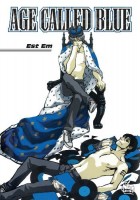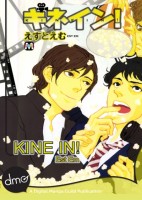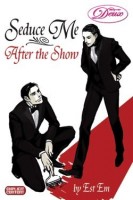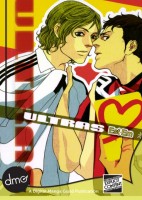My News and Reviews
Last week was a busy week for me, especially as I was travelling to and from Canada for the Toronto Comic Arts Festival, but I still managed to post a few things. The Fullmetal Alchemist Giveaway Winner was announced, for one. The post also includes a select list of some shounen and seinen manga written and/or illustrated by women mangaka. I reviewed Hinoki Kino’s No. 6, Volume 6 which is a particularly important volume in the series as it starts to approach its climax. And I also reviewed The Battle Royale Slam Book: Essays on the Cult Classic Novel by Koushun Takami, the first nonfiction book to be released by Haikasoru. I thought it was pretty great.
No links this week as I have been completely preoccupied with TCAF and all its goings-on. I’ll have a lengthy write-up about it later this week, but I’ll just say now that I absolutely adore TCAF. Since est em was one of the featured guests, I spent quite a bit of time with her manga last week. The quick takes below feature most of her manga that are currently available or have been licensed in English. (Granted, some are out of print now.) I hope that there will someday be even more est em manga translated; I really love her work. Plus, having now met her, I can say that she’s a very cool and interesting person, too!
Quick Takes
 Age Called Blue by est em. Originally released online in English and then in print by NetComics, Age Called Blue is also now available digitally from Digital Manga. Most of the volume focuses on Billy and Nick who are bandmates, roomates, friends, as well as something a bit more. Age Called Blue further develops the story and characters introduced in the manga “Rockin’ In My Head” which is included in est em’s earlier collection Seduce Me After the Show. I love the music connection in Age Called Blue. Their band, The Idiots, is something that is incredibly important to Billy, but Nick is incredibly important to him as well. Unfortunately, Nick isn’t the most responsible person and is constantly disappearing or getting into some sort of trouble, which threatens to tear the band apart just as they have the opportunity to make something of themselves. With all of the chaos caused by Nick, Billy struggles with his feelings for the other young man which can be at odds with his passion for his music. Also included in Age Called Blue is the story of how the two of them first met, which is incredibly charming. Two unrelated stories are also collected in the volume, both exhibiting their own sorts of passion.
Age Called Blue by est em. Originally released online in English and then in print by NetComics, Age Called Blue is also now available digitally from Digital Manga. Most of the volume focuses on Billy and Nick who are bandmates, roomates, friends, as well as something a bit more. Age Called Blue further develops the story and characters introduced in the manga “Rockin’ In My Head” which is included in est em’s earlier collection Seduce Me After the Show. I love the music connection in Age Called Blue. Their band, The Idiots, is something that is incredibly important to Billy, but Nick is incredibly important to him as well. Unfortunately, Nick isn’t the most responsible person and is constantly disappearing or getting into some sort of trouble, which threatens to tear the band apart just as they have the opportunity to make something of themselves. With all of the chaos caused by Nick, Billy struggles with his feelings for the other young man which can be at odds with his passion for his music. Also included in Age Called Blue is the story of how the two of them first met, which is incredibly charming. Two unrelated stories are also collected in the volume, both exhibiting their own sorts of passion.
 Kine In! by est em. The first est em release by Digital Manga Guild, the main story in Kine In! is about Ken and Mari, who are twins, and their neighbor and close friend Joe. The three of them share an interest in films and film-making and so frequently go to the movies together. However, things become a little awkward for them after a couple of love confessions are made—Mari admits to her brother that she likes Joe, Joe tells Ken that he likes him, and Ken isn’t sure how to respond to either of them. And so he chooses to figure out his feelings and express himself by making his own film with Joe and Mari’s help. Three shorter one-shot manga are also included in Kine In! One of the themes that is prominent throughout the volume has to do with familial love and the importance of those family bonds. Many of the families shown in Kine In! are unusual in some way. “The Salvia and the Barber” features another trio of friends whose relationship goe beyond friendship while “The Scenery of that Summer” follows a young man meeting his step-brother for the first time after his father dies. “Mixed Juice,” which focuses on the relationship between a college student and his professor, is the only story that breaks from this thematic pattern.
Kine In! by est em. The first est em release by Digital Manga Guild, the main story in Kine In! is about Ken and Mari, who are twins, and their neighbor and close friend Joe. The three of them share an interest in films and film-making and so frequently go to the movies together. However, things become a little awkward for them after a couple of love confessions are made—Mari admits to her brother that she likes Joe, Joe tells Ken that he likes him, and Ken isn’t sure how to respond to either of them. And so he chooses to figure out his feelings and express himself by making his own film with Joe and Mari’s help. Three shorter one-shot manga are also included in Kine In! One of the themes that is prominent throughout the volume has to do with familial love and the importance of those family bonds. Many of the families shown in Kine In! are unusual in some way. “The Salvia and the Barber” features another trio of friends whose relationship goe beyond friendship while “The Scenery of that Summer” follows a young man meeting his step-brother for the first time after his father dies. “Mixed Juice,” which focuses on the relationship between a college student and his professor, is the only story that breaks from this thematic pattern.
 Red Blinds the Foolish by est em. Although I have always enjoyed est em’s manga tremendously, it’s Red Blinds the Foolish that made me absolutely fall in love with her work. The main story in this volume is about Rafita, a brilliant young bullfighter, and Mauro, a butcher who processes the bulls killed in the arena. The two of them become intimately and passionately involved which has dramatic repercussions. Bullfighting is a crucial part of the manga and of their relationship; it is used to explore the paradoxes, complexities, and nuances of the connection between the two men. est em’s artwork is exquisite and the details she puts into the matador’s costumes are especially gorgeous. Even when dealing with heavier subjects like death and violence, Red Blinds the Foolish is beautiful and sensual. The afterword of Red Blinds the Foolish is a short travelogue of est em’s research trip to Spain to see the bullfights. Two of the other stories collected in the volume, “Baby, Stamp Your Foot” (about a novelist and his lover who makes shoes by hand) and “Tiempos extra” (about a violent soccer fan and a security guard), were actually first released in a gay men’s manga magazine as opposed to a boys’ love magazine. I particularly appreciate est em’s manga because of this crossover appeal.
Red Blinds the Foolish by est em. Although I have always enjoyed est em’s manga tremendously, it’s Red Blinds the Foolish that made me absolutely fall in love with her work. The main story in this volume is about Rafita, a brilliant young bullfighter, and Mauro, a butcher who processes the bulls killed in the arena. The two of them become intimately and passionately involved which has dramatic repercussions. Bullfighting is a crucial part of the manga and of their relationship; it is used to explore the paradoxes, complexities, and nuances of the connection between the two men. est em’s artwork is exquisite and the details she puts into the matador’s costumes are especially gorgeous. Even when dealing with heavier subjects like death and violence, Red Blinds the Foolish is beautiful and sensual. The afterword of Red Blinds the Foolish is a short travelogue of est em’s research trip to Spain to see the bullfights. Two of the other stories collected in the volume, “Baby, Stamp Your Foot” (about a novelist and his lover who makes shoes by hand) and “Tiempos extra” (about a violent soccer fan and a security guard), were actually first released in a gay men’s manga magazine as opposed to a boys’ love magazine. I particularly appreciate est em’s manga because of this crossover appeal.
 Seduce Me After the Show by est em. Seduce Me After the Show was est em’s professional debut in Japan and was likewise the first of her manga to be licensed in English. The volume was my introduction to her work, and I’ve been collecting her manga ever since. Even so early in her career est em’s storytelling was already very sophisticated and mature. Her artwork is beautifully expressive, elegant, and sensuous. It suits the main story, which features a dancer, particularly well. Backgrounds are either simple or nonexistent which makes the characters and their relationships the focus of the short manga collected in the volume. There’s no overarching plot connecting the stories found in Seduce Me After the Show but atmosphere-wise many of the manga share a sense of melancholy and loss. However, this doesn’t necessarily mean that they are sad or depressing, though they are thoughtful and contemplative. Another similarity is that most of the characters in Seduce Me After the Show are artists of one sort or another—dancers, actors, painters, musicians, and so on. Also of note: “I Saw the Blue”, the prequel to the story “Café et Cigarette” in Seduce Me After the Show, is collected in Age Called Blue.
Seduce Me After the Show by est em. Seduce Me After the Show was est em’s professional debut in Japan and was likewise the first of her manga to be licensed in English. The volume was my introduction to her work, and I’ve been collecting her manga ever since. Even so early in her career est em’s storytelling was already very sophisticated and mature. Her artwork is beautifully expressive, elegant, and sensuous. It suits the main story, which features a dancer, particularly well. Backgrounds are either simple or nonexistent which makes the characters and their relationships the focus of the short manga collected in the volume. There’s no overarching plot connecting the stories found in Seduce Me After the Show but atmosphere-wise many of the manga share a sense of melancholy and loss. However, this doesn’t necessarily mean that they are sad or depressing, though they are thoughtful and contemplative. Another similarity is that most of the characters in Seduce Me After the Show are artists of one sort or another—dancers, actors, painters, musicians, and so on. Also of note: “I Saw the Blue”, the prequel to the story “Café et Cigarette” in Seduce Me After the Show, is collected in Age Called Blue.
 Tableau Numéro 20 by est em. The most recent est em manga to be released in English is her collection Tableau Numéro 20, which includes five unrelated boys’ love, or boys’ love-esque, stories. Like many of her other manga, the stories in Tableau Numéro 20 frequently feature music, art, and dance. The titular manga and its related story “Le Visiteur” include a beautiful man who literally emerges from a painting, making them the most fantastical manga by est em that I’ve read. So much of her work and all of the other stories in Tableau Numéro 20 are based in reality, so it was interesting to see another side of est em’s creativity. Perhaps because both est em and I share an interest in Spanish culture, my favorite manga in Tableau Numéro 20 was “Rasgueado” which is about a flamenco dancer and guitarist. I’m always impressed by est em’s artwork and how expressive it is. The passion and energy on the page is almost palpable. Even when there is no dialogue there is a narrative being told through the characters’ body language and facial expressions. In “Rasgueado” in particular there are sequences of music and dance that are completely wordless that are brilliantly effective.
Tableau Numéro 20 by est em. The most recent est em manga to be released in English is her collection Tableau Numéro 20, which includes five unrelated boys’ love, or boys’ love-esque, stories. Like many of her other manga, the stories in Tableau Numéro 20 frequently feature music, art, and dance. The titular manga and its related story “Le Visiteur” include a beautiful man who literally emerges from a painting, making them the most fantastical manga by est em that I’ve read. So much of her work and all of the other stories in Tableau Numéro 20 are based in reality, so it was interesting to see another side of est em’s creativity. Perhaps because both est em and I share an interest in Spanish culture, my favorite manga in Tableau Numéro 20 was “Rasgueado” which is about a flamenco dancer and guitarist. I’m always impressed by est em’s artwork and how expressive it is. The passion and energy on the page is almost palpable. Even when there is no dialogue there is a narrative being told through the characters’ body language and facial expressions. In “Rasgueado” in particular there are sequences of music and dance that are completely wordless that are brilliantly effective.
 Ultras by est em. Along with Red Blinds the Foolish, as a whole Ultras is one of my favorite manga collections by est em. Currently it’s only available digitally, but I really do hope that it gets a print release sometime in the future. (As unlikely as that may be.) The titular “Ultras” is a story about Alfonso and Leon, two soccer fans who, after a drunken night of celebration when Spain wins the European Championship, end up in bed together. This wouldn’t necessarily be an issue except that it turns out that they are hardcore supporters of rival local teams. It’s refreshing to have a story where the plot’s anxiety isn’t about the characters being gay; in this case it’s the problem is that they’re fans of the “wrong” team. I also appreciate that the characters are well-developed and have lives outside of their relationship and soccer (though those are indeed both very important things in the manga). Al, for example, is actually an elementary school teacher and it’s adorable. And when Leon’s grandfather finds out about the two of them it’s simply one of the best scenes ever. “Ultras” and the related “Tiempos Extra” are my favorite manga in Ultras, but I enjoyed the other four stories as well. They all have a contemporary, modern sort of feel to them.
Ultras by est em. Along with Red Blinds the Foolish, as a whole Ultras is one of my favorite manga collections by est em. Currently it’s only available digitally, but I really do hope that it gets a print release sometime in the future. (As unlikely as that may be.) The titular “Ultras” is a story about Alfonso and Leon, two soccer fans who, after a drunken night of celebration when Spain wins the European Championship, end up in bed together. This wouldn’t necessarily be an issue except that it turns out that they are hardcore supporters of rival local teams. It’s refreshing to have a story where the plot’s anxiety isn’t about the characters being gay; in this case it’s the problem is that they’re fans of the “wrong” team. I also appreciate that the characters are well-developed and have lives outside of their relationship and soccer (though those are indeed both very important things in the manga). Al, for example, is actually an elementary school teacher and it’s adorable. And when Leon’s grandfather finds out about the two of them it’s simply one of the best scenes ever. “Ultras” and the related “Tiempos Extra” are my favorite manga in Ultras, but I enjoyed the other four stories as well. They all have a contemporary, modern sort of feel to them.

Well, I see what sort of week you had with manga ;) I had a Goong week once again, with some Soul Eater mixed in. But just yesterday, I finally got my first HDTV! In 2014, I know! But now I can watch How to train Your Dragon in Bluray and get future anime titles in bluray, worth it! I found out the hard way that PS3 refuses to output bluray movies into anything less than 720 (even though it can do games and will hook up to a standard TV no problem), but at least I used it as a game system in the meantime.
I haven’t read much of Goong, but I did enjoy it so I really should read more. And I actually haven’t read any of Soul Eater!
I was pretty late to the HDTV/Bluray party, myself. I only got around to getting a player last year, and that was only because my DVD player finally stopped working and needed replaced…